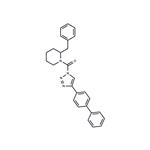| Company Name: |
Sigma-Aldrich
|
| Tel: |
021-61415566 800-8193336 |
| Email: |
orderCN@merckgroup.com |
| Products Intro: |
Product Name:KT109
CAS:1402612-55-8
Purity:>=98% (HPLC) Package:25MG Remarks:SML1364-25MG
|
| Company Name: |
SPIRO PHARMA
|
| Tel: |
|
| Email: |
eric_feng1954@126.com |
| Products Intro: |
Product Name:Methanone, (4-[1,1'-biphenyl]-4-yl-1H-1,2,3-triazol-1-yl)[2-(phenylMethyl)-1-piperidinyl]-
CAS:1402612-55-8
Purity:95% -98%HPLC Package:1GR;10GR;50GR;100GR;250GR;500GR;1KG;5KG;10KG;100KG
|
Methanone, (4-[1,1'-biphenyl]-4-yl-1H-1,2,3-triazol-1-yl)[2-(phenylMethyl)-1-piperidinyl]- manufacturers
- KT109
-

- $0.00 / 1removed
-
2025-10-27
- CAS:1402612-55-8
- Min. Order:
- Purity:
- Supply Ability: 10g
|
| | Methanone, (4-[1,1'-biphenyl]-4-yl-1H-1,2,3-triazol-1-yl)[2-(phenylMethyl)-1-piperidinyl]- Basic information |
| Product Name: | Methanone, (4-[1,1'-biphenyl]-4-yl-1H-1,2,3-triazol-1-yl)[2-(phenylMethyl)-1-piperidinyl]- | | Synonyms: | Methanone, (4-[1,1'-biphenyl]-4-yl-1H-1,2,3-triazol-1-yl)[2-(phenylMethyl)-1-piperidinyl]-;(2-benzylpiperidin-1-yl)-[4-(4-phenylphenyl)triazol-1-yl]methanone;KT-109
(KT109);KT109 >=98% (HPLC);(4-[1,1'-biphenyl]-4-yl-1H-1,2,3-triazol-1-yl)[2-(phenylmethyl)-1-piperidinyl]-methanone | | CAS: | 1402612-55-8 | | MF: | C27H26N4O | | MW: | 422.52 | | EINECS: | | | Product Categories: | | | Mol File: | 1402612-55-8.mol | ![Methanone, (4-[1,1'-biphenyl]-4-yl-1H-1,2,3-triazol-1-yl)[2-(phenylMethyl)-1-piperidinyl]- Structure](CAS/20150408/GIF/1402612-55-8.gif) |
| | Methanone, (4-[1,1'-biphenyl]-4-yl-1H-1,2,3-triazol-1-yl)[2-(phenylMethyl)-1-piperidinyl]- Chemical Properties |
| Boiling point | 637.3±53.0 °C(Predicted) | | density | 1.19±0.1 g/cm3(Predicted) | | storage temp. | 2-8°C | | solubility | DMF:10.0(Max Conc. mg/mL);23.67(Max Conc. mM)
DMSO:10.0(Max Conc. mg/mL);23.67(Max Conc. mM) | | pka | -1.02±0.70(Predicted) | | form | powder | | color | white to beige |
| | Methanone, (4-[1,1'-biphenyl]-4-yl-1H-1,2,3-triazol-1-yl)[2-(phenylMethyl)-1-piperidinyl]- Usage And Synthesis |
| Uses | KT109 is a potent and selective inhibitor of?DAGLβ. | | Biochem/physiol Actions | KT109 is a potent and selective inhibitor of Diacylglycerol lipase DAGLβ. Diacylglycerol lipases DAGLα and DAGLβ are serine hydrolases that biosynthesize the endocannabinoid 2-arachidonoylglycerol (2-AG). A lack of selective inhibitors has hampered study of these lipases. KT109 is a potent and selective DAGLβ inhibitor with an IC50 of 42 nM, ~60-fold selectivity for DAGLβ over DAGLα, and negligible activity against FAAH, MGLL and ABHD11, other key enzymes involved in endocannabinoid signaling. KT109 shows some inhibitory activity against PLA2G7 (IC50 = 1 μM) but no inhibitory activity against cytosolic phospholipase A2 (cPLA2 or PLA2G4A). The main off target inhibition against ABHD6 (IC50 = 16 nM) can be controlled for by use of the related compound, KT195, a potent (IC50 = 10 nM) and selective ABHD6 inhibitor with negligible activity against DAGLβ. KT109 disrupts the lipid network involved in macrophage inflammatory responses, lowering 2-AG, as well as arachidonic acid and eicosanoids, in mouse peritoneal macrophages. | | in vivo | KT109 (0.1-10 mg/kg; i.p.; 4 h) inhibits DAGLβ in mice with good potency and selectivity, exhibiting cross-reactivity with only a handful of additional serine hydrolases in macrophages[1].
KT109 (5 mg/kg; i.p.; 4 h) lowers 2-AG, as well as Arachidonic acid (HY-109590) and eicosanoids, in mice peritoneal macrophages. KT109 reduces secreted TNF-α levels in lipopolysaccharide-stimulated macrophages[1].
KT109 (1.6-40 mg/kg; i.p.) reverses the allodynic responses of Lipopolysaccharides (HY-D1056) (LPS)-treated paw, but i.c.v. or i.t. administration of KT109 do not alter LPS-induced allodynia in C57BL/6J mice[2].
Repeated KT109 (40 mg/kg; i.p.; once daily for 6 days) administration prevents the expression of LPS-induced allodynia, without evidence of tolerance in C57BL/6J mice[2].
KT109 reverses allodynia in the chronic constrictive injury (CCI) (40 mg/kg) and chemotherapy-induced neuropathic pain (CINP) (1.6-40 mg/kg) models and lacks discernible side effects in C57BL/6J mice[2].
| Animal Model: | DAGL-β (-/-) and (+/+) on C57BL/6J mice (23-40 g) (injected with 2.5 μg LPS into the plantar surface of the right hind paw after the 5th dose.)[2] | | Dosage: | 40 mg/kg | | Administration: | Intraperitoneal injection (i.p.). once daily for 6 days | | Result: | Repeated administration prevented the expression of LPS-induced allodynia, without evidence of tolerance. |
| Animal Model: | Daglb+/+, Daglb+/- and Daglb-/- mice on C57BI/6 and 129/SvEv mixture background were first treated intraperitoneally (i.p.) with 4% (w/v) thioglycollate 4 d before to induce recruitment of macrophages to the peritoneal cavity[1] | | Dosage: | 0.1, 0.5, 1, 5, 10 mg/kg | | Administration: | Intraperitoneal injection (i.p.). 4 h | | Result: | Completely inactivated DAGLβ at doses as low as 0.5 mg/kg body weight. Also inhibited ABHD6.
Time-course studies revealed that produced complete inhibition of macrophage DAGLβ by 1 h after in vivo treatment, and this inhibition was maintained for > 16 h.
|
| Animal Model: | Pla2g4a+/+ and Pla2g4a-/- mice on a BALB/c background and Daglb+/+, Daglb+/- and Daglb-/- mice on C57BI/6 and 129/SvEv mixture background were first treated intraperitoneally (i.p.) with 4% (w/v) thioglycollate 4 d before to induce recruitment of macrophages to the peritoneal cavity[1] | | Dosage: | 5 mg/kg | | Administration: | Intraperitoneal injection (i.p.). 4 h | | Result: | Marked decreases in 2-AG content in macrophages.
Significant increases in the DAGLβ substrate SAG, and reductions in arachidonic acid and in the arachidonic acid-derived prostaglandins PGE2 and PGD2.
Significantly reduced secreted TNF-α levels in lipopolysaccharide-stimulated macrophages, and this suppressive effect was also observed in macrophages from Daglb?/? mice.
|
| Animal Model: | DAGL-β (-/-) and (+/+) on C57BL/6J mice (23-40 g)[2] | | Dosage: | 1.6, 2.5, 5, 20, 40 mg/kg | | Administration: | Intraperitoneal injection (i.p.). | | Result: | Reversed LPS-induced allodynia in wild-type mice in a dose-dependent manner, but does not further alter the anti-allodynic phenotype in DAGL-β (-/-) mice. |
|
| | Methanone, (4-[1,1'-biphenyl]-4-yl-1H-1,2,3-triazol-1-yl)[2-(phenylMethyl)-1-piperidinyl]- Preparation Products And Raw materials |
|